
Scrooge meets Marley’s Ghost in John Leech’s original illustration (1843).
Following on my yearly, post-Thanksgiving reading of Charles Dickens’ immortal classic A Christmas Carol, I started thinking about all the many (many) stage, TV, and movie versions of the oft-told tale I had seen over the years and realized that I have been exposed to as many Scrooges, Jacob Marleys, and Tiny Tims as could populate – or over-populate – a quaint Victorian village. Which, I suppose, is not surprising. Since the novella’s publication in December of 1843, A Christmas Carol is possibly the most re-adapted literary property in the Western canon and, in fact, could be argued to have entirely shaped the popular imagination regarding the meaning of the season and the celebration of the holiday. Indeed, the annual appearance of Marley’s Ghost to the cold-hearted miser Ebenezer Scrooge – and his subsequent haunting by three Spirits of the Season – is as seasonally-festive a tradition for many as buying a tree, exchanging cards, or decorating one’s home with brightly-colored electrical lights.
As my mind tends to work this way anyway, I decided as a “fun” experiment this Christmas season to research, track down, and view as many film and television A Christmas Carols as I could conceivably find within a two-week period, and then type up whatever the results might be. What I discovered was that, with so (so) many interpretations of Scrooge, Marley’s Ghost, Nephew Fred, Tiny Tim, and the rest out there, I began to develop a critical stance towards the endless repetition of characters, situations, and dialogue. The power and appeal of the story, I feel, is self-evident; however, when viewed back-to-back, even A Christmas Carol‘s over-familiarity begins to breed, if not quite contempt, a certain weariness, to say the least. As such, though it is not my custom to order, rank, and grade, I found I could not help but compare both the virtues and demerits of each version and, like Scrooge himself, to question each A Christmas Carol‘s right for being.
In short, is there, using Scrooge’s own words against him, a “surplus population” of Scrooges? Though it would take any viewer, even this one, as many eternities through which the Ghosts of Christmas Past, Present, and Yet To Come effect Scrooge’s spiritual reclamation to see ALL the A Christmas Carols ever made, I’d hope that having subjected myself to no less than 22 versions will here suffice!
22. A CHRISTMAS CAROL
(1997, DiC, dir. Stan Phillips)
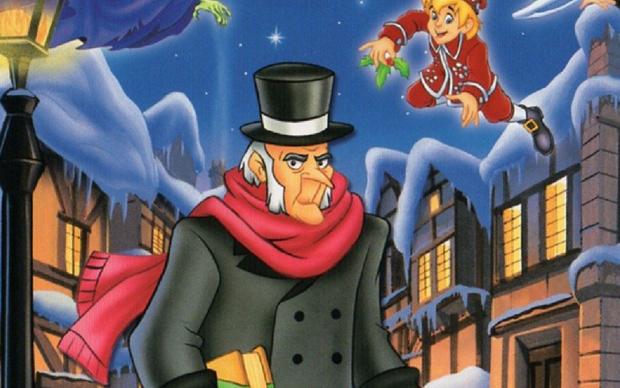
From Inspector Gadget to The Littles, the animation studio that dominated the Saturday morning and afterschool programming of my childhood was, undoubtedly, DiC. Like Saturday morning cartoons, though, the studio itself is now defunct, but if a nighttime shot on a kid dreaming of a star shining in his bedroom sounds familiar – escaping through an open window to dot a lower-cased ‘i’ in the night sky with the squeaky-voiced pronouncement of “deek!” – then I’d venture you possibly to be, like myself, a child of the 80s. Yes, DiC, like its contemporaries Filmation and Hanna-Barbera, was quite adept at selling toys and sugary breakfast cereals to a generation of unwary brats, but a painful viewing of their seasonal attempt at adapting classic nineteenth century literature reveals that the studio’s ambitions should never have strayed far from advertisement-disguised-as-children’s-entertainment. With the voice talents of Tim Curry, Ed Asner, and Whoopi Goldberg – among other paycheck-cashing vocal performers – this 72-minute animated musical gives Scrooge a bulldog named “Debit!” and full-stops in the middle of the proceedings to interpolate an unrelated song about Santa Claus. Indescribably bad.
21. RICH LITTLE’S CHRISTMAS CAROL
(1979, HBO, dir. Trevor Evans)
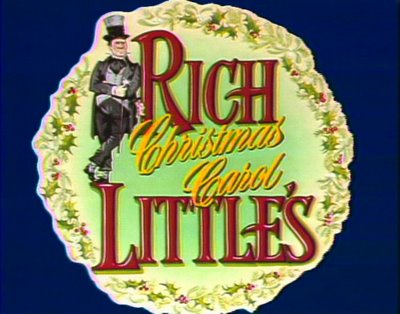
This late 70s HBO special from master impressionist Rich Little – who was most famous in his day for his impersonation of Tonight Show host Johnny Carson – became an annually-broadcast tradition for the subscription-based cable channel during its early years, but is now consigned to the same fate of its near-contemporaries, including the infamous Star Wars Holiday Special (1978), as a dated curiosity solely available for viewing off of a BetaMax taping uploaded to YouTube. Complete with trailers for Superman II and now-inappropriate feminine hygiene commercials, Little’s one-man show inadvertently distills late 70s pop culture to its essence by casting “himself” in every role of A Christmas Carol, impersonating random entertainers and characters from the past 80+ years of show business. So, if – in and of itself – Little doing Paul Lynde as Bob Cratchit, Richard Nixon as Jacob Marley, Truman Capote as Tiny Tim, and (the inevitable) Johnny Carson as Nephew Fred is one’s idea of HIGH-larity, then I daresay one might enjoy this special because that, unfortunately, is where the joke ENDS. However, I will say that Little’s decision to anchor the special in the personality of W.C. Fields was an inspired choice for Ebenezer Scrooge as Fields was about as close to a Dickensian character as Classic Hollywood ever produced!
20. A CHRISTMAS CAROL
(2004, Hallmark Entertainment, dir. Arthur Allan Seidelman)
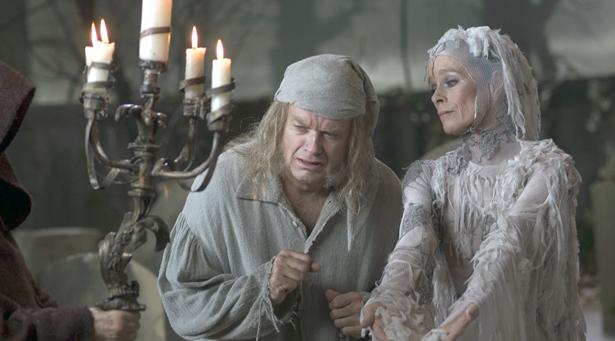
A Christmas Carol gets the Tim Rice/Andrew Lloyd Webber treatment in a TV-movie musical adapted from a mid-90s Broadway Extravaganza. Starring Kelsey Grammer (Cheers, Frasier, The Simpsons) as Scrooge, this Hallmark Channel production has boards-bursting dancing, rafters-raising operatics, and casement-cracking theatricality galore; however, it simply isn’t Dickens. Besides unaccountably changing the Dickens-penned backstory on Scrooge in Christmas Past, this A Christmas Carol gives short shrift to both Christmas Present and Yet To Come by oversimplifying Scrooge’s motives and therefore making his change-of-heart less believable. Perhaps I’m being a trifle harsh on this earnest, heartfelt effort, but for this viewer the everything-but-the-kitchen sink approach to classic literature comes uncomfortably close to what an earlier version, the modern day-set, Bill Murray-starring Scrooged (1988), was in fact satirizing. As such: NEXT!
19. A CHRISTMAS CAROL
(2009, Disney, dir. Robert Zemeckis)
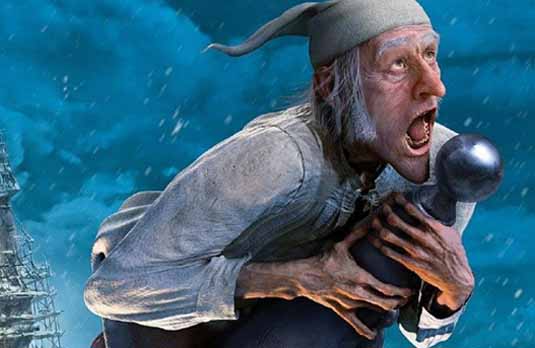
Robert Zemeckis’ half-decade-long flirtation with motion-capture animation technology – which commenced with another Christmas fable, The Polar Express (2004) – came to a merciful halt with this multiple-Jim Carreys-starring version of Dickens’ classic tale. Taking visual inspiration from the original 1843 illustrations by John Leech, this A Christmas Carol has imagination to spare – and is a fine evocation, initially, of both Dickens’ story and Victorian London – but ultimately becomes a wearying viewing experience – ALL those details, ALL those voices – that overwhelms the simple power of the original story. (The absolute nadir comes when the film turns into an elaborate chase sequence of Scrooge by a ghostly hearse through the streets and sewers of London; a set-piece more appropriate for a multi-million dollar action film, NOT A Christmas Carol.) The choice of Jim Carrey as Scrooge (and all the Ghosts) is a telling one because, like the actor himself, the realer-than-real animation format – a digital process similar to the live-filmed “tracing” technique known as “RotoScope” – is possibly better taken in small doses and/or utilized with a degree of restraint definitely NOT displayed here.
18. THE CHRISTMAS CAROL
(1949, Jerry Fairbanks Prod., dir. Arthur Pierson)
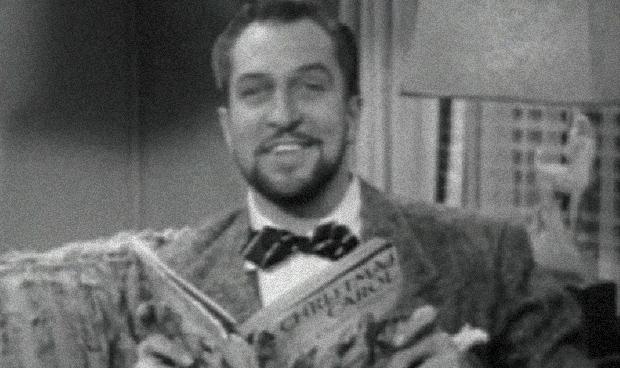
From the earliest period of live television comes this Christmas Day, 1949 half-hour broadcast of A Christmas Carol, unaccountably titled THE Christmas Carol and “Sponsored by Magnavox!” This holiday special is, according to Wikipedia, the first instance of television using the medium of television to advertise television (which always seemed a bit counter-productive, not to mention redundant, to me), and is possibly more interesting as a piece of cultural history than as a legitimate adaptation of Scrooge, Marley, the Ghosts, and all the rest. Narrated (and on-screen presented in a cozy-looking reading room) by Vincent Price, the story blazes through all the necessary plot points in its scant 25-minute running time – Scrooge being mean to various well-wishers of the season in his counting-house, Scrooge’s visitation by Marley and the ghosts, Scrooge’s encounter with his mortality on a (misspelled) gravestone (“Ebeneezer Scrooge”) – before safely arriving at Scrooge’s spiritual reclamation. As a purely functional re-telling of A Christmas Carol, one presumes this version more importantly succeeded in its more pressing goal for the season: that of selling more Magnavox-brand televisions.
17. A CHRISTMAS CAROL
(1999, TNT, dir. David Jones)
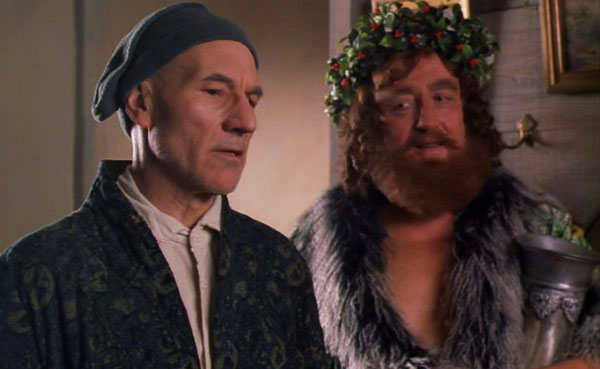
Patrick Stewart stars in this made-for-cable-TV version of A Christmas Carol, which was based on the actor’s popular theatrical readings of the Dickens’ original for the London stage. Like the earlier 1951 and 1984 versions of the tale, this A Christmas Carol is a good deal darker and period-realistic than many of its “competitors”; however, this version, I felt, added little that hadn’t already been explored in previous incarnations. Incorporating a few elements usually left out of various adaptions – including the trip across land and sea witnessing various Christmases in Christmas Present, along with the allegorical children Ignorance and Want concealed beneath the Ghost of Christmas Present’s robe – the visual spectacle of it all, like the Disney motion-capture version from a decade later, nevertheless fails to register the emotional core of Dickens’ tale, while the script simplifies, and in many cases entirely changes, Dickens’ powerful prose. Stewart acquits himself well in the role of Scrooge, and he is surrounded by a well-mounted production, yet this A Christmas Carol remains indistinguishable, and therefore unmemorable, in comparison to the countless versions made before it.
16. SCROOGE, OR, MARLEY’S GHOST
(1901, Paul’s Animatograph Works, dir. Walter R. Booth)
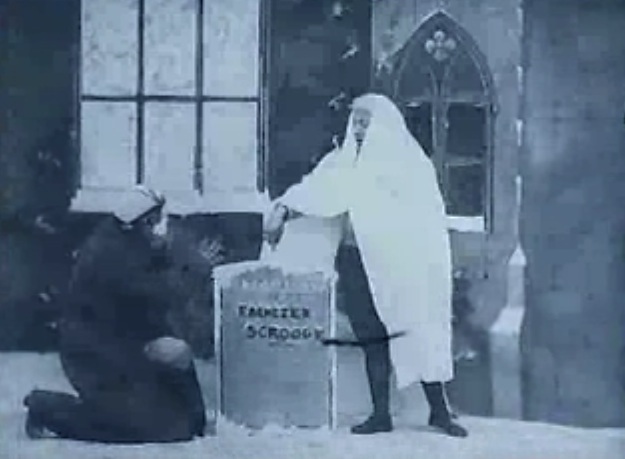
This approximately 5 minutes of silent footage – 620 feet in length, shot on 35-mm, silver-nitrate stock – is not only 114-years-old this past November, but is, in fact, the first known, surviving film version of A Christmas Carol. To put that into historical perspective, England had then-recently mourned the death of Queen Victoria in January of that year and the film was shown to her son and successor, King Edward VII, in a Royal Command performance later that December. Not only were contemporaries of Dickens then-still living (such as his mistress, the actress Ellen Ternan, who lived until 1914), but the cruelties and injustices, the beauties and terrors that directly inspired Dickens’ 1843 novella to “raise the ghost of an idea in [its] readers”, was as immediate for the original viewers of this antique film as living memory. Irrespective of its relative merit to versions of A Christmas Carol that succeeded it, Scrooge, Or, Marley’s Ghost has the virtue of being first, and therefore set a standard for all Scrooges and Marleys that followed.
15. A CHRISTMAS CAROL
(1910, Edison Manufacturing Co., dir. J. Searle Dawley)
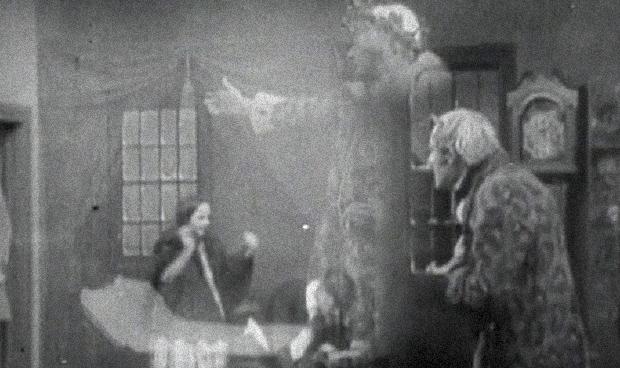
The second oldest version of A Christmas Carol that I could find traverses space, distance, and time to arrive downloaded on one’s laptop as a freely-available, 512 KB digital file courtesy of the Internet Archive. Originating from Thomas Edison’s glass-domed “Picture Studio” on Decatur Avenue in the Bronx, NY, this multi-media marriage of art and technology was an early example of what was to become a defining innovation of the century. A phantasmagoria of trick photography and proscenium theatrics, the medium was obviously still in its infancy, but this single reel of film, approximately 10 minutes and 1,500 feet in length, still has the power to delight and move in equal measure. As possibly the first written narrative to seriously explore notions of time travel in the nineteenth century, doesn’t it seem appropriate, then, that A Christmas Carol should have become the most-adapted story in a visual medium that broke down barriers of space, distance, and time in the century that followed?
14. BLACKADDER’S CHRISTMAS CAROL
(1988, BBC, dir. Richard Boden)
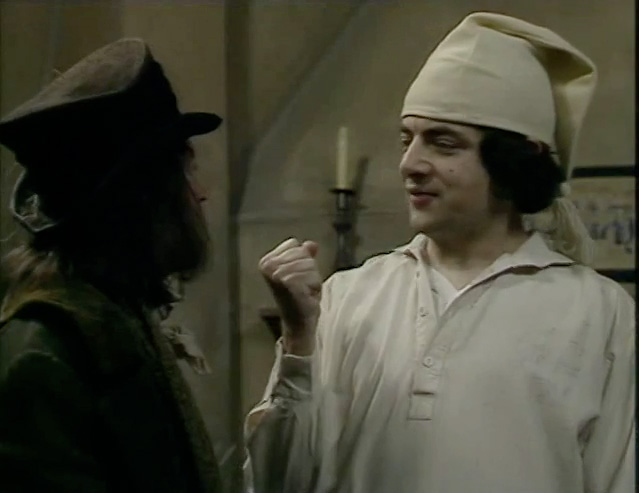
Many this side of the pond are familiar with Rowan Atkinson’s popular character, and ode to silent comedy, Mr. Bean. What many may not realize, though, is that Atkinson is possibly MORE acclaimed in his homeland, the UK, for his triumphal 1983-89 multi-generational, multi-period portrayal of Britain’s poisonous Blackadder Dynasty. Accompanied by faithful dogsbody “Baldrick” (Tony Robinson) through the Medieval, Elizabethan, Regency, and Great War eras, the compellingly villainous Blackadder must contend with rivals, idiots, hangers-on, and variously insane authority figures – enacted in different periods by Miranda Richardson, Tim McInnerny, Stephen Fry, and Hugh Laurie – as the opportunistic heel slashes and burns his way through 600 years of British history. The 1840s, though, finds one “Ebenezer Blackadder, Esq.” as a “moustache shop” proprietor who is hailed hither-and-yon as the “kindest and loveliest man” in Victorian England. Well, a visitation by the Spirit of Christmas (Robbie Coltrane) yields predictable results – as the misguided soul is shown how his ancestors lied and cheated, and generally had a lot of fun doing it – and Blackadder soon claims his rightful place as a “complete and utter [something-or-another]” just in time for Christmas morning! Yes, it’s A Christmas Carol in reverse, and, as such, definitely distinguishes itself among the many (many) more sickeningly heartfelt adaptations regarding “the milk of human kindness”: “It’s gone off, Baldrick. It stinks.”
13. A CHRISTMAS CAROL
(1977, BBC, dir. Moira Armstrong)
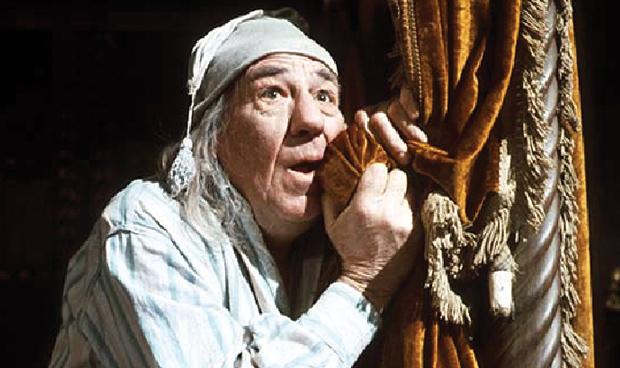
This hour-long BBC adaptation from 1977, starring Michael Hordern as Scrooge, is possibly the most obscure and overlooked version of A Christmas Carol I could find. Overshadowed, perhaps, by the later 1984 television production, this version is an eerie and poetic evocation of Dickens’ tale, emphasizing atmosphere and mood over flashy effects. Hampered by a budget and time constraints, this A Christmas Carol nonetheless distinguishes itself for its shadowy lighting and spare production design. Undoubtedly TOO “spare” for some, though, as some of the scenes – especially those set in Christmas Past – appear to be acted in front of illustrations, this TV-movie cultivates a welcome, minimalist tone for the most part and is notably the only version which portrays Bob Cratchit and his large family as living in the sort of cramped and deplorable, hovel-like conditions one would expect for a clerk subsisting on 15 shillings a week. Also effective is the period-appropriate “London Fog,” which, at the start of Britain’s manufacturing age, was already covering the metropolitan area in a thick shroud of industrial pollution, obviously lending much to the crucial scene in the graveyard of Christmas Yet To Come when the mist clears to reveal the name “Ebenezer Scrooge”! Actor Hordern had famously played Marley’s Ghost in both the 1951 Scrooge and the 1971 TV animated special and here proves himself more than capable in the main role.
12. SCROOGE
(1935, Twickenham Film Studios, dir. Henry Edwards)
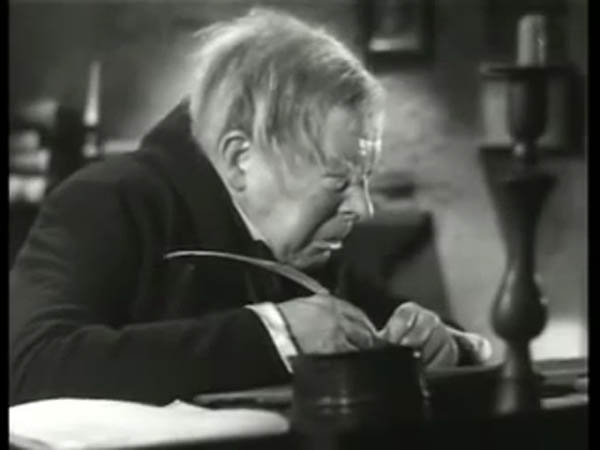
Perhaps no actor during his lifetime was more associated with the role of Ebenezer Scrooge than Sir Seymour Hicks. The theatrical tradition of the seasonal tale stretches nearly back to the date of the novella’s first publication in 1843: a significant source of Dickens’ income, in fact, was exhausting public readings of his works, and his annual performance of A Christmas Carol inspired countless theatrical productions of Scrooge, Marley, and the rest from the 1840s on. (In fact, at the time of Dickens’ death, it is estimated that there were seven concurrent productions of A Christmas Carol in London alone.) Hicks first performed the role in 1901, at the age of 29, and, like Dickens himself, annually revisited A Christmas Carol through the late 1930s, first playing the role on film in a 1913 silent movie, of which this version is a remake. Here, the first full-length sound film of A Christmas Carol, titled Scrooge, suffers somewhat from what might presume to be the constraints of its budget – Jacob Marley and the Ghost of Christmas Past only appear as an off-screen voice and a lighting effect, respectively – but this dark and atmospheric production benefits greatly both from the authority of Hicks’ commanding performance and a grimmer, grimier portrayal of Victorian London than the later MGM filming, to which Scrooge is often compared.
11. A CHRISTMAS CAROL
(1954, CBS, dir. Ralph Levy)
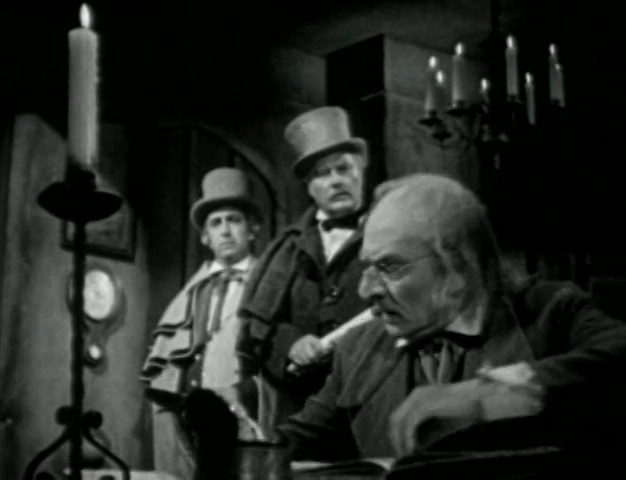
American television’s second attempt at Dickens’ tale is an hour-long musical with an unusual pedigree: filmed ON film – at a time when most contemporary television productions were broadcast live – this A Christmas Carol stars Frederic March as Scrooge and Basil Rathbone as Marley’s Ghost. Also boasting a script by Pulitzer Prize-winning playwright Maxwell Anderson (Winterset, Anne of a Thousand Days), this musical adaptation was scored by none other than Bernard Herrmann, who later earned screen immortality for his iconic work in the best-known films of Alfred Hitchcock (Vertigo, North by Northwest, Psycho). Yes, at a scant hour’s length, and with songs to boot, the story is necessarily condensed, but yet there is fire in the two great actors’ performances, poetry in Dickens’ prose, and, best of all, the songs and musical cues both recall composer Herrmann’s brooding and atmospheric work for Orson Welles in Citizen Kane (1941) and eerily anticipate certain terrifying string passages from Psycho (1960)! Music creates its own atmosphere, and adds immeasurably to the impact of a film, so possibly I may have been less favorably impressed with this seasonal production had Bernard Herrmann’s score been used more sparingly, but, as it is practically wall-to-wall here, this A Christmas Carol becomes moody, foreboding, and, yes, even suspenseful. One can easily see here why Alfred Hitchcock chose the composer for his film of the following year, 1955’s The Trouble with Harry!
10. MR. MAGOO’S CHRISTMAS CAROL
(1962, UPA, dir. Abe Levitow)
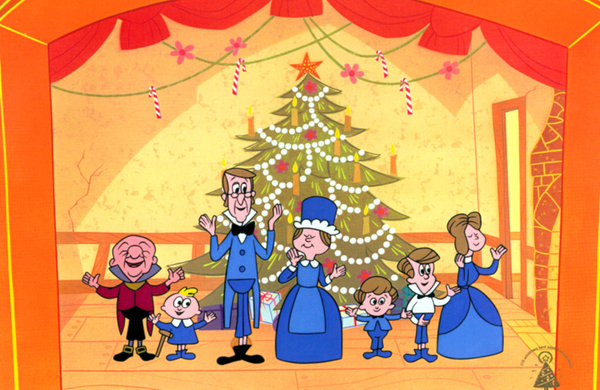
It is quite fitting, I think, that the Golden Age of the animated Christmas special is bookended by two adaptations of A Christmas Carol: both Mr. Magoo’s take on the classic tale here and the Rankin & Bass The Stingiest Man in Town from 1978. Mr. Magoo‘s is, by far, the more memorable of the two as animation studio UPA’s near-sighted, perpetually grumbling klutz – voiced by Jim Backus – makes a perfect Scrooge. Ingeniously framed by Mr. Magoo performing the role on Broadway, this version does rather come off as a contemporary Broadway production of the day – think The Music Man (1957) or My Fair Lady (1956) – which, I suppose, is not surprising considering the ingenious, witty songs for the special are by the great songwriting team of Jule Styne and Bob Merrill, who would go on to write the music and lyrics for Funny Girl (1964). Also surprising for a version admittedly “freely adapted” from the original – here, the Ghost of Christmas Present visits Scrooge before the Ghost of Christmas Present, while the character of Scrooge’s nephew, Fred, is entirely omitted – is how much of Dickens’ prose is retained and spoken line-for-line by voice actors including Morey Amsterdam, Royal Dano, Jack Cassidy, and Paul Frees, in addition to Backus. All in all, pretty darned impressive for a version aimed squarely at kids!
9. SCROOGED
(1988, Paramount, dir. Richard Donner)
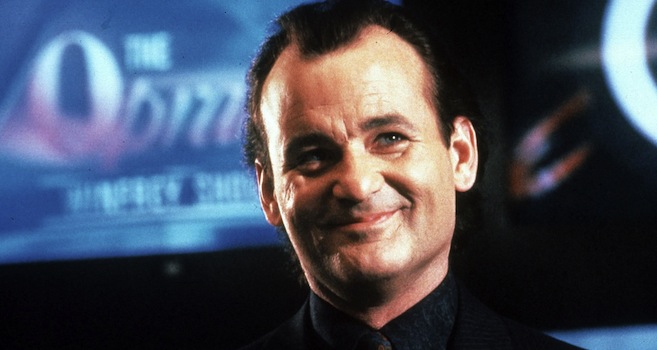
Richard Donner’s darkly comic Christmas fantasy comes towards the end of the 1980s and, as a modern-day adaptation of A Christmas Carol, seems in retrospect a fitting cinematic coda for an era defined by unbridled greed and rampant commercialization… or something. Actually, this is Bill Murray’s big return to the silver screen – he had been (mostly) absent since his huge success with Ghostbusters (1984), and soon-after critical drubbing for The Razor’s Edge (ibid.) – and the Scrooge-like role of heartless TV executive “Frank Cross” seemed tailor-made. As a kid who grew up during the 80s – and, like most of my contemporaries, did most of that “growing” while planted squarely in front of the TV – the more satirical aspects of ‘shock ads’ (“Your life might just depend on it!”) and ridiculously overproduced holiday specials (“Buddy Hackett as Scrooge!”) wasn’t all that far a cry from what networks were then-slathering all over the airwaves daily. (I’d swear on a stack of something-or-others that Lee Majors actually DID make some absurd Christmas action TV-movie at some point.) My mom took me to see Scrooged when it first came out and, as an astute critic of both film AND the career of Bill Murray, pointed out that Murray, appropriately, was possibly the first Scrooge to wield sarcasm and bitter irony like blunt weapons. For an actor whose entire career seems like some monumental act of sarcasm anyway, screendom’s most spitefully sarcastic Scrooge was a perfect, festeringly festive fit for the one-and-only comic actor.
8. A CHRISTMAS CAROL
(1938, MGM, dir. Edwin L. Marin)
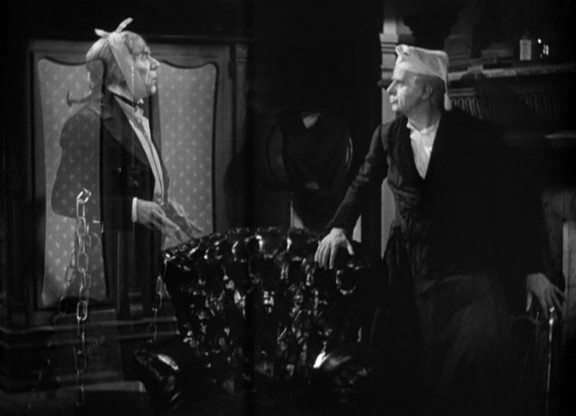
If Sir Seymour Hicks was Britain’s favorite Ebenezer Scrooge, then America’s favorite was undoubtedly Lionel Barrymore. As played on the radio from 1934 to 1953 – and only missing a couple years in between – Barrymore’s crotchety voice was the country’s aural image of the character through the Depression, World War II, and the early post-war years. He was also during that time under contract a full two decades at MGM, the Rolls-Royce of film studios, and, as such, was possibly the most recognizable character actor in Hollywood. Illness and infirmity, alas, prevented the actor from taking the lead role in the studio’s sterling production of Dickens’ tale (Barrymore did, however, narrate the trailer for the film), but his “ghost,” if you will, is decidedly present in actor Reginald Owen’s fine interpretation of the character. If the largest failing of the British Scrooge from three years earlier was lack of money and poor production values, this MGM-produced A Christmas Carol has realistic snowfalls, expansive sets, and glossy photography to spare. Yes, this is a storybook, idealized version of Dickens’ London, but Hollywood’s top studio, MGM, specialized in sentiment and, as such, this version remains the sentimental favorite of many classic movie fans to this day.
7. MICKEY’S CHRISTMAS CAROL
(1983, Disney, dir. Burny Mattinson)

As the first original Mickey Mouse cartoon made by Disney since the early 50s, the theatrical release of Mickey’s Christmas Carol – casting Mickey, Scrooge McDuck (obviously), Donald, Goofy, Jiminy Cricket, Willie the Giant, and sinister Peg-Leg Pete in all the major roles – was undoubtedly a big deal in December of 1983, but I more distinctly recall its TV debut on NBC a year later, which was a HUGE deal. Taping it on our BetaMax, the 25-minute short was fairly ground to its tape-magnetic elements through repeated family viewings. A real delight for fans of both Dickens and Disney, this clever re-imagining of A Christmas Carol is funny, atmospheric, and even just a tad frightening (I wouldn’t be surprised if Scrooge’s final plunge into his fiery, yawning casket haunted the dreams of my 7-year-old self several months afterwards). Moreover, in addition to its surprising fidelity to the source material, the animators were clearly inspired by their chance to work with classic Disney characters and this version features some of the studio’s best animation in decades. My favorite moment? Goofy as the Ghost of Jacob Marley exiting Scrooge’s chambers in true Goofy-fashion: tripping over Scrooge’s cane and falling down the stairs with a lusty Goofy Holler!
6. THE MUPPET CHRISTMAS CAROL
(1992, Disney, dir. Brian Henson)
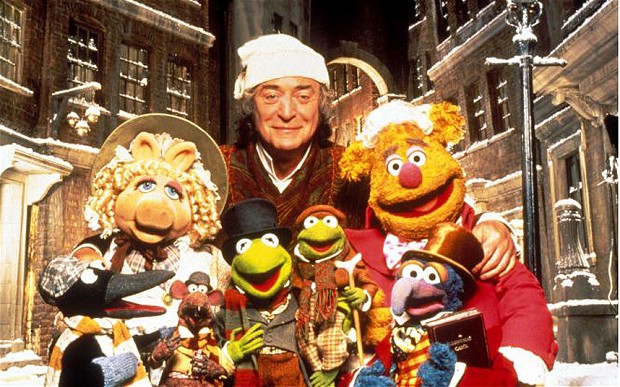
The first Muppets movie after the passing of Jim Henson in 1990 was a gamble for both Disney and the surviving Muppet players, but their efforts resulted in one of the best, most beloved versions of A Christmas Carol. Featuring songs written by Paul Williams – who had also provided the music for the very first The Muppet Movie (1979), including Kermit’s plaintive themesong “The Rainbow Connection” – this version manages to capture the spirit of Dickens’ tale while also remaining true to the anarchic, unruly essence of the Muppets. (My favorite moment here? Gonzo grabbing Rizzo by the scruff of his neck and using the rat to wipe off a snow-frosted window.) From their earliest TV commercials, through children’s programming and their own classic show, the strength of the Muppets has been their ability to seamlessly interact with people; to make felt, stuffing, and googly eyes come alive when placed alongside real performers such as Michael Caine’s fine work here as Ebenezer Scrooge. As such, classic literature makes a good, affectionate target for the Muppets to both celebrate (the real emotion that’s present when Scrooge asks the Ghost of Christmas Present about Tiny Tim’s fate) AND poke fun at (professional hecklers Statler and Waldorf are cast as the Ghosts of Jacob AND Robert Marley), adding dimension and interest to so (so) many more heartfelt and earnest versions of the tale – which unfortunately become increasingly hard to take when viewed back-to-back like this. All I can say in this regard, then, is God bless the Muppets, every one!
5. SCROOGE
(1970, Cinema Center Films/UK, dir. Ronald Neame)
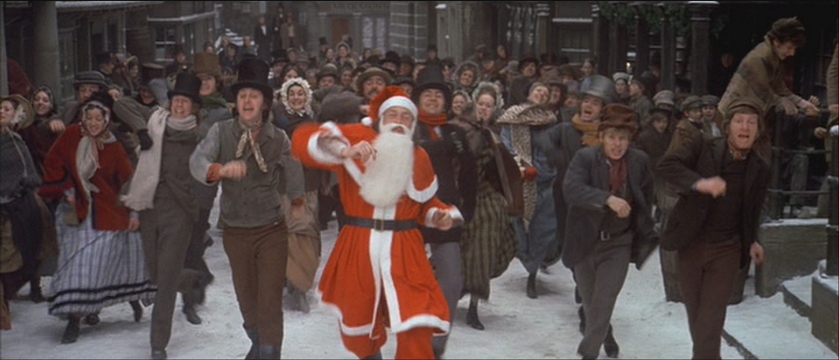
Leslie Bricusse’s big, old-fashioned movie musical adaptation of A Christmas Carol, starring Albert Finney in the title role, represents, alongside the following year’s big screen Fiddler on the Roof, the last gasp of the big, old-fashioned movie musical. Splashy and boisterous, there’s infectious energy to spare in each clever lyric and click-clacking dance turn echoing down the cobblestones of an expansively-recreated Victorian village. There had been musical versions of A Christmas Carol both before (TV’s The Stingiest Man in Town from 1956) and after (a Hallmark Channel production from 2004), but what sets this version apart is that here the everything-but-the-kitchen sink approach actually works. Director Ronald Neame had been producer on director David Lean’s landmark Dickens productions of Great Expectations (1946) and Oliver Twist (1948) and here infuses this musical interpretation of A Christmas Carol with the realistic style of those all-time classics, combined with a heady atmosphere which recalls great movie musicals of the 1950s like Seven Brides for Seven Brothers (1954) and It’s Always Fair Weather (1956). (Ever want to see an elaborate routine performed by a dancing debtor on Scrooge’s coffin? Well, here’s your chance.) Also on hand is Alec Guinness as Marley’s Ghost, whose quiet, whispering eccentricity is one of the more memorable interpretations of the role.
4. AN AMERICAN CHRISTMAS CAROL
(1979, ABC, dir. Eric Till)
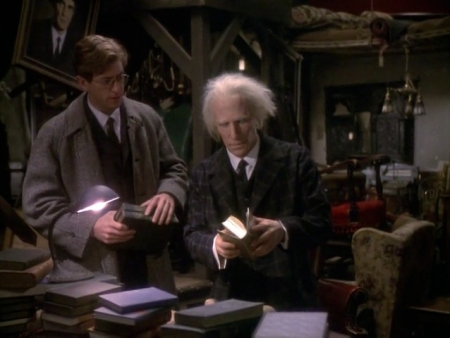
Released as a TV-movie at the height of the actor’s Fonz-fame, Henry Winkler, under pounds of aging make-up, portrays an American Depression-era miser named “Benedict Slade” in this updating (and emigrating) of A Christmas Carol. As undoubtedly the biggest surprise on my list, I didn’t have much hope for this version, based on my random happening upon the unprepossessing DVD cover found on a holiday cart at my place of employment, but I was quickly won over — first by its accurate recreation of a New England village during the Depression, and second by its insightful and understated attempt at resetting the well-worn story in another time and place — and soon realized I was watching a near-masterpiece of re-imagining. Like the later Scrooged, A Christmas Carol by Charles Dickens exists as a story within the story, with parallels between the respective miserly characters, but this version, while hitting all the story points of the ghostly former business partner and the hauntings by Spirits of the Season (here played by victims of the wayward soul’s skinflint business practices), makes the story’s themes relevant to its resetting by directly addressing distinctly American concerns in this particular historical period which continue to the present day. Beyond his obvious success with one of the most popular TV characters of all-time, Henry Winkler proves adept at underplaying his role as a heartless American entrepreneur – never appearing outright evil, but simply misguided – and Dickens’ stated goal of “convincing one soul” of the error of his ways is surely achieved in Winkler’s sensitive performance.
3. A CHRISTMAS CAROL
(1971, ABC, dir. Richard Williams)
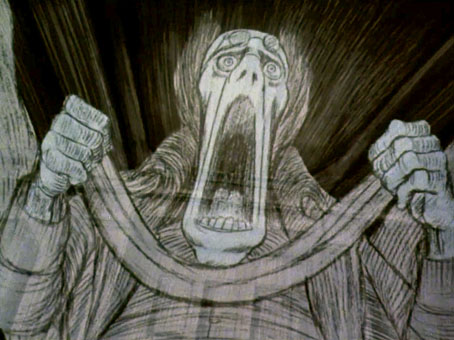
Originally made for television, animation director Richard Williams (Who Framed Roger Rabbit?) and producer Chuck Jones teamed for this ambitious production of A Christmas Carol – certainly the most artistically-successful version yet attempted – which ended up winning the Academy Award for Best Animated Short Film in 1971. Narrated by Michael Redgrave, Scrooge and Marley’s Ghost are voiced by Alastair Sim and Michael Hordern, reprising their roles from the 1951 Scrooge, and though the film runs a scant 25 minutes, this animated adaptation somehow manages to be incredibly faithful to its source material, with all of the narration and dialogue spoken directly from the original text. Taking visual inspiration from the original 1843 illustrations by John Leech, along with well-regarded pen-and-ink renderings by fantasy illustrator Milo Winter, the film is a motion-visual triumph, not only realizing scenes described by Dickens that had never been filmed before — such as Scrooge and the Ghost of Christmas Present’s flight over land and sea, witnessing various celebrations of Christmas — but also portraying Dickens’ milieu in a shadowy and sinister manner that seems appropriate for the time period. In one characteristically-bravura sequence, during Christmas Yet To Come, the scene shifts from the steps of the lavishly-appointed Exchange, flash-cutting through the streets of London to a close-up on the bottomless-black iris of a furtive rat stalking about a squalidly-appointed rag shop! Yes, this A Christmas Carol is, in parts, the stuff of nightmare but, precisely like the original, wrests its “reclamation” and joyful tidings of the season through the darkness of what has come before.
2. A CHRISTMAS CAROL
(1984, CBS, dir. Clive Donner)
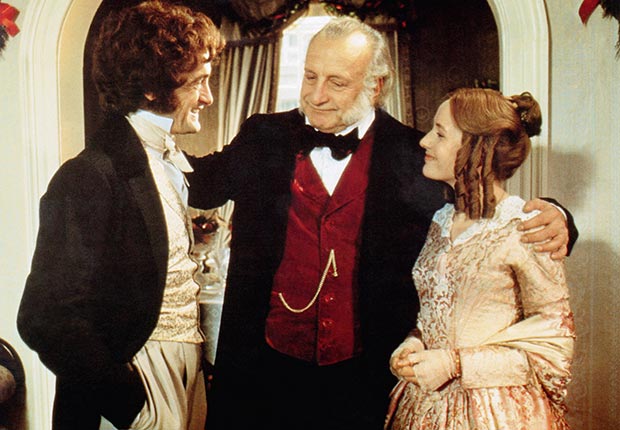
Filmed entirely in the living museum-preserved Medieval market town of Shrewsbury (in Shropshire, England), this US/UK co-production (debuting on television in the US, but shown theatrically in the UK) is, in my humble opinion, the finest and most faithful adaptation of A Christmas Carol yet attempted. Starring a brilliant George C. Scott as Scrooge, an actor within whom a volcano of barely-suppressed rage always seemed to contend, this is also, I feel, the best cast version as well, with Frank Finlay absolutely terrifying as Marley’s Ghost; David Warner sensitively beleaguered and touching as Bob Cratchit; Angela Pleasance and Edward Woodward otherworldly and overwhelming, respectively, as the Spirits of the Season; and, pulling double duty as narrator and Nephew Fred, Roger Rees a fine, youthful stand-in for the author. (Heck, even young Anthony Walters is here the first Tiny Tim to visibly appear as if he is actually sickly and dying.) Admittedly, I am slightly prejudiced in favor of this A Christmas Carol, as it was my family’s chosen annual viewing during the Christmas season, but no matter how many times I’ve seen this film, there are certain deliveries of Dickens’ prose in this adaptation which seem to me their greatest interpretation. Once one has heard, say, Edward Woodward as the Ghost of Christmas Present’s rejoinder to Scrooge’s earlier comment about the “surplus population” – “It may well be that, in the sight of Heaven, you are more worthless and less fit to live than MILLIONS like this poor man’s child” – one may never be able to un-hear the power and depth of these actors’ readings.
1. SCROOGE
(1951, Renown Pictures, dir. Brian Desmond Hurst)
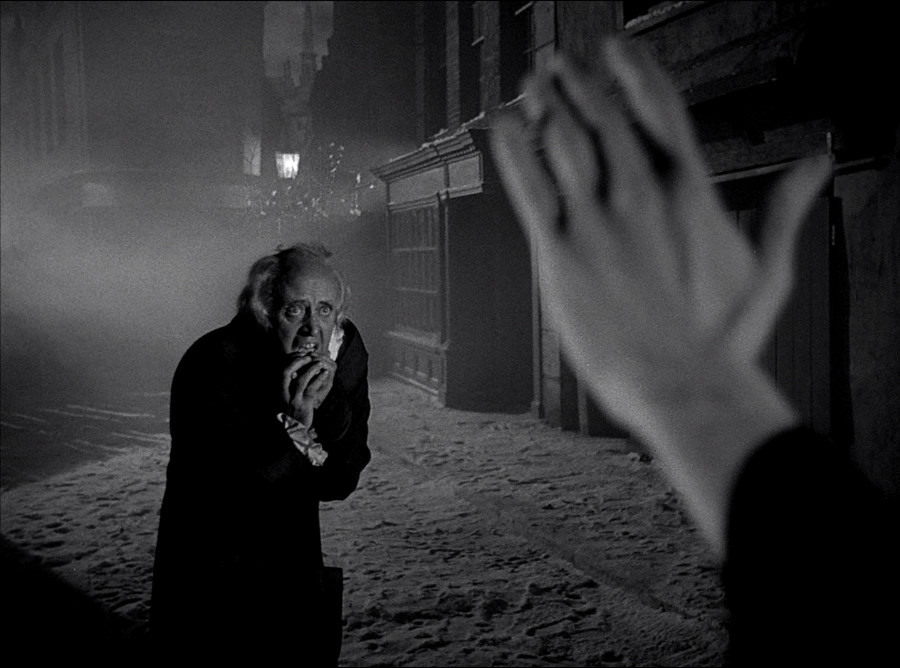
The incomparable Alastair Sim stars as Ebenezer Scrooge in a version and interpretation of A Christmas Carol that, for many (many), is absolutely definitive, 1951’s British production of Scrooge. Released under the title of A Christmas Carol in the US, the film had a muted reception during its initial theatrical run – many contemporary American reviewers found it “too dark” – before gaining in stature through subsequent theatrical re-issues and repeated holiday showings on TV. (By the early 70s Scrooge topped annual critics’ polls as the greatest Christmas film ever made; a position the film has held ever since.) Sim perfectly captures Dickens’ vision of the character as a “squeezing, wrenching, grasping, scraping, clutching, covetous old sinner” – indeed, even greatly physically resembling John Leech’s 1843 illustrations of Scrooge – and projects an icy coldness equal to Dickens’ description of his miserly “adamantine heart” that gradually gives way, through his ghostly visitations, to the most compelling and humanly believable change-of-heart yet captured in any version of A Christmas Carol. (Unable to contain his irrepressible joy in the last shot of the film, Scrooge breaks down in a gale of giddy laughter – “I don’t deserve to be this happy!” – and helplessly throws his pen over his shoulder; a wonderful “ad-lib” on the part of Sim’s.) Like Laurence Olivier’s 1948 Hamlet, this version benefits greatly from a deeper exploration of a well-worn character (we learn who Scrooge is and, more importantly, why he is), which not only adds depth and nuance to the actor’s interpretation, but also renders more powerful (and believable) the character’s transformation. As a character with possibly the greatest “arc” in all literature – from “sinner” to “saint” – I can’t imagine that there is an actor alive who would turn down the role if offered (perhaps ultimately explaining why A Christmas Carol has been so endlessly adapted?); however, after 1951 they would have the daunting and unenviable task of reckoning with Sim!

